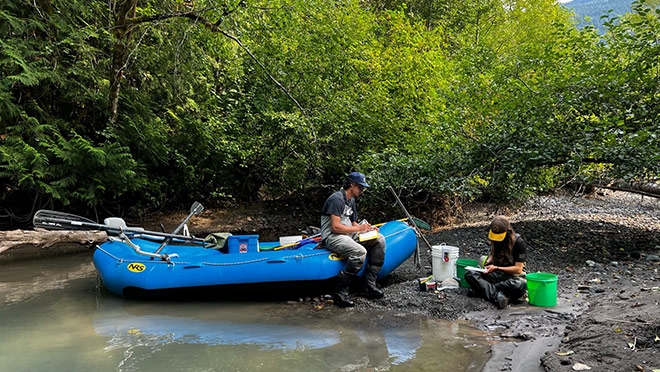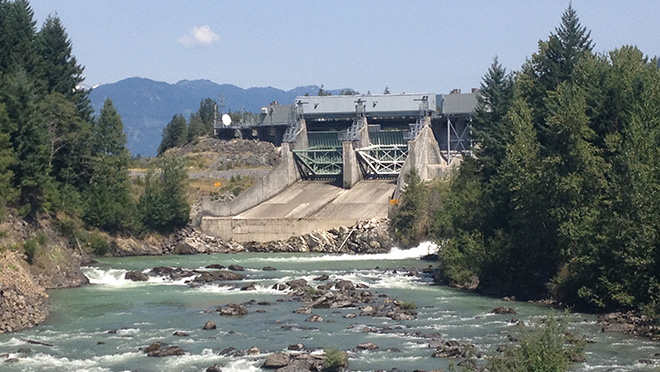BC Hydro works to protect fish on Cheakamus River

Salmon and trout protection at heart of planning flows
Working along the Cheakamus River near Squamish is not the sole focus for Sterling Pearce, a registered professional biologist with BC Hydro. In addition to spending time on the river monitoring water levels and the number of fish, he's a local resident, passionate about the River as he enjoys rafting and biking after hours.
"There are so many beautiful spots on the Cheakamus, and it feels really rugged," says Pearce. "There are a few places you see a house or a cabin, but it just feels remote. A beautiful river system. And it's super dynamic. The river changes a lot from season to season, year to year."
We play a big role in the flows along the Cheakamus River, including twice-per-year flow reductions – known as "rampdowns". Typically, every August and November, BC Hydro has planned rampdowns from the Daisy Lake Dam designed to ensure there's enough water to meet Water Use Plan (WUP) minimum flow requirements while also reducing the risk of stranding salmon and other fish.
Weather and other conditions along the river can trigger flow increases, resulting in rampdowns at any time of year, and they can be tricky. Reduce flows too slowly, and spawning fish will take the opportunity to build nests – known as redds – in shallow pools that disappear (or "dewater") as the river recedes. Reduce it too fast, and some juvenile and adult salmon don't have time to get back into the main channel.
Every rampdown down is carefully planned and managed by determining flow conditions, the fish in the river, and the risks at the time.
Twice in the past three years, thousands of spawning pink salmon were stranded after BC Hydro ramped down flows on the Cheakamus River. This happened during large fall rainstorms, with operations teams delicately balancing public safety, flood risk, and environmental needs. Pearce was there last October, along with other BC Hydro staff – plus anglers and others on the River – salvaging salmon and sending them back to the main channel.
"We really work to bring down the number of stranded fish but last year was tough," says Pearce.
"We know we have storms in the fall, and that this sort of thing happens on natural river systems as well. Despite doing our best to plan ahead, we had a large number of fish stranded on the first day of the ramp. It's not an outcome we wanted. We responded by bringing in larger crews and slowed down the rates of the remaining ramps."
In 2018, we committed to studying the effects of flow reductions in what's known as the Cheakamus Adaptive Stranding Protocol (CASP), including working more closely with stakeholders and First Nations.
"We're always going to be learning. We're open to making improvements, by continually working and engaging with local First Nations and stakeholders," says BC Hydro fisheries biologist Taylor Ward.
By doubling down on consultation, we're hoping to strike a better balance between protecting the environment and keeping the public safe while also delivering clean, reliable power to customers.

Big storms, small reservoir, and power to 96,000 homes
For decades, the Cheakamus generating station has been providing British Columbians with enough low cost and clean electricity to power the equivalent of 96,000 homes per year.
Located 40 km north of Squamish on the unceded traditional territory of the Squamish Nation, Tseil-Watuth Nation and Lil'wat Nation, the Daisy Lake Dam impounds water flowing south in the Cheakamus River creating Daisy Lake Reservoir. The water in Daisy Lake Reservoir takes one of two paths to the Squamish River. It's either released from the dam down a 26-km stretch of the Cheakamus River to its confluence with the Squamish River, or it's diverted through a tunnel that runs through Cloudburst Mountain to the Cheakamus Generating Station on the Squamish River.
BC Hydro operates the dam, its discharge facilities, and the generating station in accordance with its water licences and the 2006 WUP, which sets guidelines to balance power generation with fish and flood protection, as well as recreation. The 2006 WUP is currently under review and will be informed by the CASP. Daisy Lake is a relatively small reservoir for the inflows it can see during heavy rainfall events, meaning storm events will result in large fluctuating flows on the Cheakamus River.
All rivers in Squamish pose a risk of flooding, and all have caused damaging floods in the past. In 1984, heavy flows destroyed a log bridge across the Cheakamus River and damaged several homes. And in October 2003, the biggest flood to hit Squamish in 50 years caused evacuations and damaged the BC Rail line.
Few pink salmon in this year's run, during August rampdown
Because there's a very small pink salmon run this year – pinks spawn on the Cheakamus River in odd numbered years – we took the opportunity to perform critical maintenance on the tunnel to the Cheakamus Generation Station this spring and summer.
That has meant that no water from the Daisy Lake Reservoir is getting diverted to the Squamish River via the Cheakamus Generation Station during the maintenance. The result has been higher than usual flows on the Cheakamus River. Add to that a cool, wet spring with a higher than normal snowpack in mid-June that shifted the snowmelt later in the summer.
"This has been an unusual year for weather, and if large numbers of pinks were in the river, the risks would have been greater," says Pearce.
While the small number of pinks this year theoretically makes Cheakamus River management easier, the Daisy Lake Dam rampdown in August is still considered a higher risk period where juvenile fish of multiple species, including steelhead and Coho, could be affected, without CASP measures in place.
The week of August 22, we reduced flows on the Cheakamus River following WUP requirements. The plan to help mitigate the risk of stranding fish included:
- Ramping at a slow rate over several early mornings
- Keeping daily changes in the river small
- Monitoring and salvaging fish from isolated pools
"We implemented a 'pre-ramp survey' to try to get a better sense of how many fish were in the river and what the risk was," says Pearce. "One of the big unknowns is how the fish are going to respond to what we're doing, and it's highly varied based on the time of year and river levels."
Learn more about our operations on the Cheakamus River.